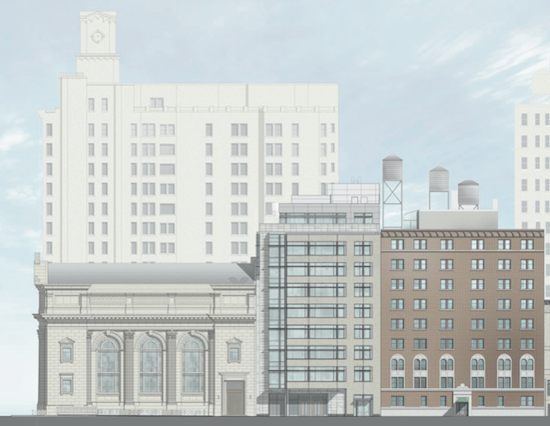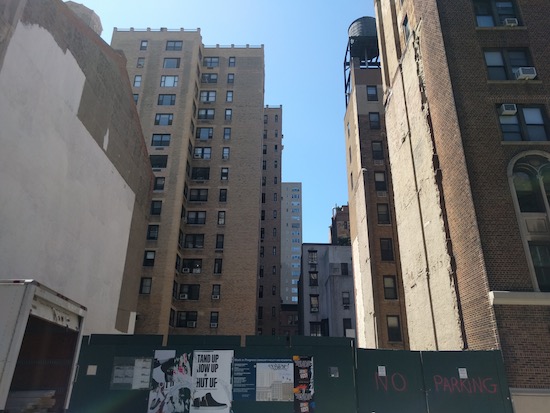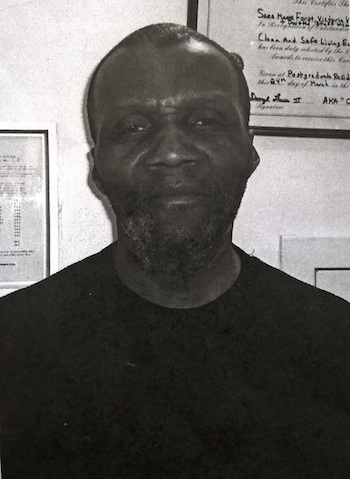
Congregation Shearith Israel is seeking approval to build the grey building in the center, but is encountering opposition. Image via PBDW Architects.
By Joy Bergmann
The oldest Jewish congregation in America has been waiting nearly as long as Moses wandered the desert to construct a new building on a lot on West 70th Street, but it may have to wait a bit longer. Synagogue Congregation Shearith Israel got a mixed result at a community board hearing about its nine-story project last week.
In fact, few if any of the 70 participants at the packed Community Board 7 Land Use Committee meeting Wednesday evening got what they wanted.
The synagogue had been seeking CB7’s recommendation to the Board of Standards and Appeals to:
- Extend its construction allowance for new common house facilities – topped by four luxury condos to subsidize the project – at 8 West 70th Street, and
- Characterize as “minor” the design changes the synagogue made subsequent to earlier plans that gained the project a significant zoning variance from BSA. This nod from CB7 would help clear the way for BSA to grant a “letter of substantial compliance” with the approved 2008 plans and restart construction efforts that stalled in early 2016 when the Department of Buildings noticed design discrepancies, revoked the synagogue’s permits and issued a stop work order.
“It is the same project, with some minor nips and tucks for design development,” said Zachary Bernstein, attorney for the synagogue.
Bernstein’s presentation characterized the synagogue’s changes as small adjustments: code-required separation of staircases, finalized structural partition placement and finalized HVAC systems and equipment. “The plans you’ll see today…which are the official plans for this project, match the original BSA plans.”

The building formerly on the site has already been demolished. Photo by Joy Bergmann.
Not everyone agreed with that assessment. Several speakers wanted CB7 to send the synagogue back to the starting line, not just back to BSA.
Preservation group Landmark West! submitted a statement outlining its opposition, saying the latest changes, “further exacerbate negative impacts of this project cited by CB7 in its 2007 resolution,” when CB7 denied Shearith Israel a positive recommendation to BSA.
During the meeting, Landmark West’s attorney David Rosenberg went further, “This committee cannot and should not rubber-stamp this application because the applicant lacks credibility,” he said. “There has been misrepresentation and obfuscation…they like skipping steps.”
Assemblyman Richard Gottfried suggested shenanigans by the synagogue, as evidenced by the DOB’s stop work order. “If you need to change your plans, you do it above board,” he said. “You don’t go ahead until the Buildings Department catches you and makes you stop.”
Many synagogue members implored CB7 to move the project forward, citing the need for ADA-compliant accessibility, a place for its prodigious archives given its status as the oldest Jewish congregation in America, appropriate space for educational programs, a Kosher kitchen and other facilities.
“We need this building to continue [Shearith Israel’s] historic legacy. The congregants have had to give their time and money to keep this thing going. We’re really trying to make this work,” said Laury Frieber. “Circumstances change. Even zoning laws change. We’ve had to play catch up with that. To impugn the integrity of this congregation because of those sorts of nit-picky details, it just shocks me.”
Details noted by area residents focused largely on the HVAC system modifications and whether the updated design had the same amount of square footage devoted to the synagogue’s “programmatic needs” – e.g. classrooms, ritual areas and other spaces dedicated to religious practice. Having “programmatic” needs is key to whether the BSA is allowed to make zoning variances for religious and educational institutions.
Cindy Antonucci, board president of 18 West 70th, an adjacent property, remarked, “That ventilation system is going to be abutting people’s apartments and our open air space. That was never presented, never contemplated before.”
Saul Dennis raised auditory and olfactory concerns regarding generators and exhaust systems. “It could be like living above a fast-food restaurant.”
“I understand the odors will be Kosher,” quipped Committee Co-Chair Richard Asche in a rare moment of levity during the three-hour proceeding.
The Committee asked Bernstein for technical documentation that would prove his assurances that the HVAC systems would be within legal decibel limits and eliminate odors. He did not have those materials at hand.
The Committee also puzzled over reworked floorplans. Bernstein assured them the classrooms were of the same number and that programmatic space usage had not materially changed. They asked if the synagogue had a side-by-side comparison of square footage for various spaces, 2008 vs. 2016. Bernstein did not have those materials immediately available either.
The Committee was not getting what it wanted. Commentary continued.
Jean Martowski, 91 CPW co-op board member, “We urge CB7 not to be influenced by CSI’s lobbyists, Capalino+Company, and hold CSI to the standards required by all other applicants.”
“I’ve lived on the Upper West Side my entire life and I’ve learned not to trust the assurances of real estate developers,” said Rob Hart. “The Board should deliberate with all the facts in hand, not just the vague assurances that have been presented tonight.”
The CB7 Land Use Committee voted:
- Yes. We recommend BSA approve the synagogue’s request for a construction extension (through February 2020), but
- No. We recommend BSA disapprove the synagogue’s amendment to plans as minor because of insufficient information
The Committee said they would reconsider their disapproval if provided with additional information.
What happens next in this 9-year (some say 33-year) saga?
Bernstein says the synagogue will soon supply the Committee with all the requested information. The synagogue will present the matter at the full CB7 Board meeting on September 6th, with the hope that – having reviewed said materials – the Committee will change their disapproval and encourage the full board to recommend BSA proceed with the updated plans.
Because the BSA considers the Community Board’s input on the application, BSA will likely schedule their hearing for after receipt of the final Community Board resolution. The BSA will vote at a subsequent meeting to that, after consideration of testimony received.
Bernstein says if the BSA approves the extension of time and the updated plans, the plans would be filed at DOB (the BSA-approved plans would supersede prior plans filed with DOB). Approval of the updated construction plans by DOB would allow for construction to commence, which the synagogue anticipates in late fall.
Project opponents showed no signs of capitulation.
To be continued…into a fourth decade.
We published more on the history of this project here.








“I’ve lived on the Upper West Side my entire life and I’ve learned not to trust the assurances of real estate developers,”-RobHart
Let the debate begin!
I can understand the neighbors not wanting HVAC odors and noise near their (I assume) rooftop deck. It’s less clear to me why historical preservation is a factor here. The existing building has already been demolished. What am I missing?
We are so overcrowded now and a 61 story bldg. is going up at 69th that should also be stopped !
Community Board 7 has, since the ’80s, given real estate developers carte blanche.
Enough already with building and construction on the Upper West Side.
It is getting to me too much.
The skyline of NYC used to be beautiful and was a real treat when landing at JFK. Now it is just a mishmash of odd shaped and sized bldgs.
It wasn’t that long ago we had farms in the Bronx. Those were the good old days when there were mob hits instead of brunch at the Boat Basin. Let’s roll back some of this so called “progress” and get back to a kinder and gentler UWS like the one that existed before they ever built that hideous Lincoln Center. West Side Story was set in those illustrious days. No one is writing musicals about the glories of the UWS now.
Why did we pave the streets again?
Re: ” Let’s roll back some of this so called “progress” and get back to a kinder and gentler UWS like the one that existed before they ever built that hideous Lincoln Center.”
So Lincoln Center is “hideous”? WHY? Exactly WHAT about it is “hideous”?
–Is it the huge central plaza with its spectacular fountain displays?;
–Or is it the gorgeous performance buildings (designed by name-architects like Philip Johnson, Eero Sarinnen, etc.) so beautiful when all lit up at dusk;
–Perhaps it’s the spacious tree-shaded plazas where everyone can find a place to sit absolutely free for as long as (s)he chooses;
–or is it Damrosch Park, home to the FREE performances every summer, part of Lincoln Center Out of Doors;
–Oh, wait a mo’…Got it! It was MUCH MUCH better when the area was a dangerous crime-ridden slum of aged 5-story walk-up tenements where people were afraid to venture out at night.
Re: “West Side Story was set in those illustrious days.”
West Side Story was NOT set specifically in the slum area preceding Lincoln Center ; rather it was SET IN OUR COLLECTIVE IMAGINATIONS of what a gang-ridden area might look like.
When the film industry (which always gets New York WRONG) decided to capitalize on a great musical it lucked out because the blighted area was about to be bull-dozed, and so the abandoned tenements provided great location footage!
Promoting building at will?